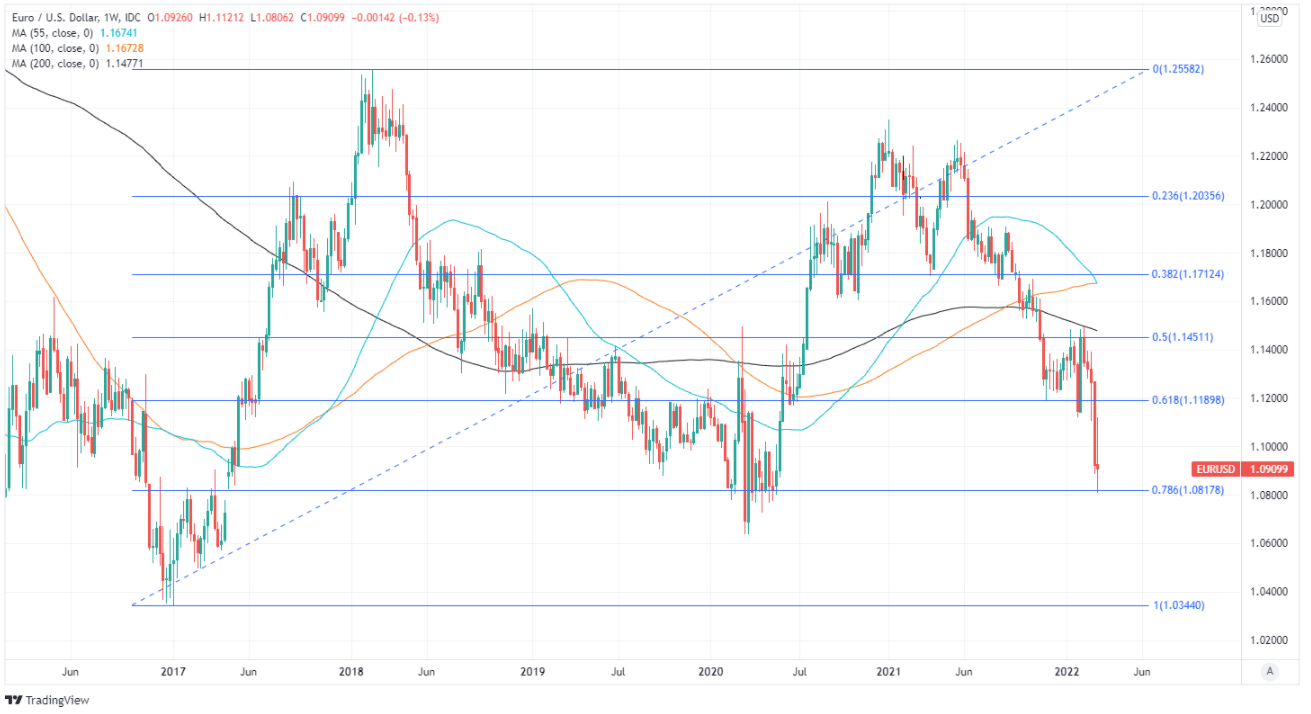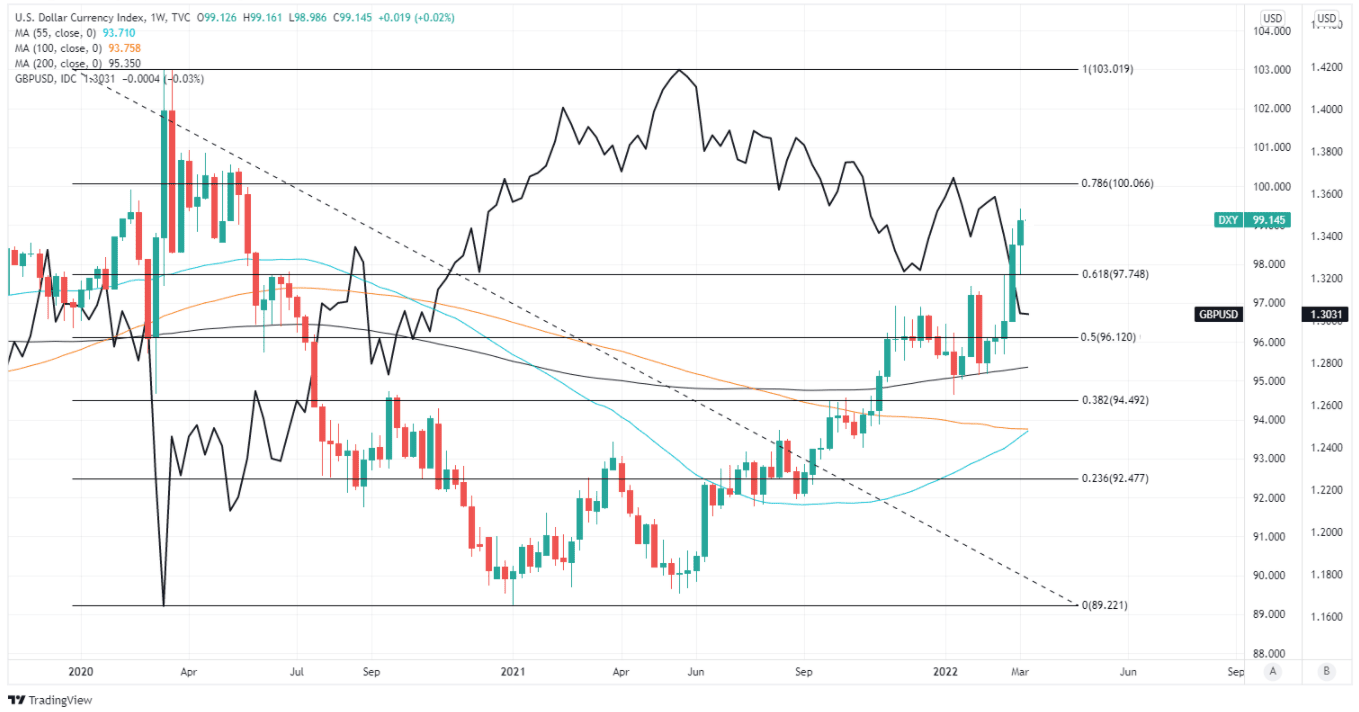Euro / Dollar Week Ahead Forecast: Supported Near 1.08 as Fed Decision and Guidance Eyed
- Written by: James Skinner
-
- EUR/USD steadier & finding feet above 1.0800
- Calmer global markets supportive of EUR/USD
- But Ukraine conflict still poses risk to EUR/USD
- Fed commentary, guidance also key to outlook

Image © European Central Bank
The Euro to Dollar rate attempted to draw a line underneath earlier losses last week but the Ukraine conflict and market response to Wednesday’s commentary and policy guidance from the Federal Reserve (Fed) are likely to be the arbiters of if it can hold more durably above the recent low at 1.08.
Europe’s single currency rallied strongly from last Monday’s low around 1.0807 as commodity prices fell and stock markets pared early-March losses amid speculative suggestions that diplomatic efforts might be able to bring an end to the Russian invasion of Ukraine.
The Euro rose further on Thursday when the European Central Bank (ECB) brought forward to June the date at which its Asset Purchase Programme would reduce its monthly government bond purchases to €20BN, before formally acknowledging that its interest rates could rise in the near future.
But it wasn’t long at all before Bureau of Labor Statistics data suggested that U.S. inflation rose to 7.9% in February, leading the greenback to strengthen broadly while pulling the Euro-Dollar rate back toward its roughly 1.09 starting level for this week.
“Even though the hawks appear to have wrestled control at the ECB, the uncertainties over the Eurozone economic outlook have meant that the Governing Council’s policy outlook has been heavily caveated. Although the EUR has fought back from its weakest post-invasion levels, we still view the single currency as vulnerable and anticipate choppy conditions for the EUR ahead,” says Jane Foley, head of FX strategy at Rabobank.
Above: Euro to Dollar rate shown at weekly intervals with Fibonacci retracements of 2017 rally indicating possible areas of technical support.
- EUR/USD reference rates at publication:
Spot: 1.0912 - High street bank rates (indicative band): 1.0503-1.0606
- Payment specialist rates (indicative band): 1.0814-1.0870
- Find out more about market-beating rates and service, here
- Set up an exchange rate alert, here
While the single currency’s recovery was scuppered just above the 1.11 handle on Thursday, the sharp rally from near the round number of 1.08 has led multiple analysts to infer that this could be a short-term line in the sand or limit on the downside for the Euro-Dollar rate.
"We'd be remiss to not point out strong multiple time frame support for euro in the 1.08s that favors an optimistic scenario. The test and rally this week from the 1.08s supports our year ahead technical view that a triangle pattern is forming on the weekly chart and this may be where the euro bottoms in 1H22 if it remains above 1.08" says Paul Ciana, chief technical strategist at BofA Global Research.
"Looking ahead, we're on watch for a bottom formation and bullish signals in the daily chart to reinforce 1.08 as relevant," Ciana wrote in a Friday review of the Euro-Dollar charts.
Ciana and BofA Global Research colleagues are not alone in being attuned to the prospect of the 1.08 level marking a short-term bottom for the Euro as TD Securities and Credit Suisse have both suggested that a rough 1.08 to 1.12 trading range is likely ahead.
{wbamp-hide start}
{wbamp-hide end}{wbamp-show start}{wbamp-show end}
But much still depends for the single currency on whether oil, gas and overall energy prices remain under wraps over the coming days, while the Euro-Dollar rate is also likely to be sensitive to the new forecasts and policy guidance provided by the Federal Reserve on Wednesday.
“The EU’s efforts to limit its energy dependence on Russia will continue and can keep global energy prices elevated while increasing the share of European energy trade settled in USD. This can become a drag on EUR/USD as selling by Eurozone energy importers picks up,” says Valentin Marinov, head of FX strategy at Credit Agricole CIB.
“Elsewhere, we expect the Fed to deliver a 25bp hike next week. Of key importance for investors will be any indications about the pace and the aggressiveness of the bank's future tightening policy. These will be a function of the updated 'dot plot' and the economic projections,” Marinov and colleagues wrote in a Friday research briefing.
The Fed is widely expected to lift its interest rate on Wednesday for the first since December 2018 and Chairman Jerome Powell already suggested in March testimony to Congress that this would likely be a 0.25% increase that takes the top end of Fed Funds interest rate range to 0.50%.
Above: U.S. Dollar Index at weekly intervals with Fibonacci retracements of 2020 fall indicating possible areas of technical resistance for USD, and shown alongside Pound-Dollar rate. Includes selected moving-averages. Click image for closer inspection.
With pricing in the overnight-indexed-swap market still implying that some investors see a high probability of a larger increase than that, it’s possible that Wednesday’s decision will be something of an anticlimax for the Dollar that leaves EUR/USD untroubled.
But this is far from assured and not least because Chairman Powell also told Congress this March that “we’re prepared to raise by more than that” typical 0.25% increment if U.S. inflation does not “peak and then begin to come down” in the months ahead.
The danger is that the Fed’s latest dot-plot of forecasts will show Federal Open Market Committee (FOMC) members anticipating a larger number of rate rises ahead than were guided for back in December, while GDP forecasts could reveal a dampened growth outlook, both of which might be supportive of the Dollar and could keep the Euro on the back foot.
“As things stand and with large negative risks, we think the ECB will wait to hike until Q1- 2023. By then, the Fed will have already hiked by 225bps according to our economics department’s forecasts,” says Juan Manuel Herrera, a strategist at Scotiabank.
“Rate differentials will weigh on the EUR over the next few quarters. We see the EUR weakening to the 1.06 level in the coming weeks, while a ramp up in Russian aggression and signs of depressed growth in the bloc (possibly a recession ahead) could see the EUR aim for the ~1.0350 low of early-2017,” Herrera and colleagues also warned on Friday.






